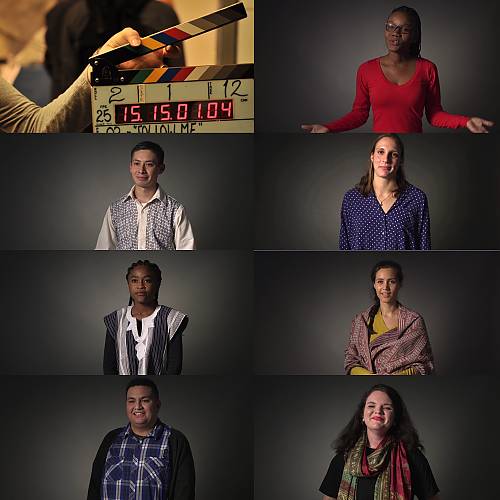The dynamic personal stories of young people around the world featured in this exhibit showcase the power of intangible cultural heritage to directly impact how we think and feel in the present.
Ever evolving, intangible cultural heritage is a significant cultural resource regenerated during the very process of being shared. Myriad traditions and living expressions passed on from generation to generation, continue to be a source of creativity and inspiration in contemporary societies. Consequently, young people and intergenerational relationships are vital for ensuring that intangible cultural heritage is safeguarded.
Created in collaboration with four passionate participants from the tenth UNESCO Youth Forum (25-26 October 2017, UNESCO Headquarters), this audio-visual exhibition invites everyone into a participatory space of intercultural dialogue by bringing together new narratives from diverse places around the globe.
Discover different ways that young people today engage with their intangible cultural heritage. Hear more about their personal efforts to safeguard and transmit their vibrant living traditions in the present and for future generations. See how their engagement has enriched not only their lives, but enhanced their broader communities.
After you walk through and enjoy the exhibition, take a moment of reflection: What does intangible cultural heritage mean for you today? When and how did you learn these traditions? And don’t miss the chance to share your personal stories of intangible cultural heritage.
Personal stories of youth
Alena Murang
She is a musician, visual artist, and educator. Drawing from her native Kelabit roots, Alena’s art allows her to share these stories with audiences around the world. She is one of the first and only women to perform and teach the sape’, a traditional lute instrument from Borneo that was once taboo for women to even touch. Rearranging and reinterpreting songs she learned from her elders, Alena sings in the Kelabit and Kenyah languages, and performs in festivals and shows internationally. In 2018 she released “Re Lekuah”, the first music video ever to be produced in Kelabit, a language with no more than 4,000 speakers.Alena also founded “ART4 Studio” in 2015, an organisation dedicated to working with other artists to keep heritage arts relevant in modern, urban settings.
Jan Cristhian Mata Ferrer
Jan is a Mazahua textile artist from the community of San Felipe Santiago, Villa de Allende, State of México, Mexico. Fascinated by the unique forms and beautiful colours of the textiles, ten-year old Jan asked his mother to teach him embroidery only to be told: “a man cannot embroider, man must dedicate himself to other things”. Since then, Jan devoted himself to learning the artform and changing stereotypes of male embroiderers, ultimately challenging traditional gender roles.Driven by a conviction to share his cultural heritage via textiles, Jan gives workshops and participates in conferences and exhibitions. To date, he’s won ten national prizes of Popular Art, but The State Prize of Youth 2015 to Merit Artistic and Cultural Career and the international Young Crafts Prize, Tenerife, Spain 2016 are two career highlights.
Jan’s achievements have significantly altered community opinions and inspired the young people who take his workshops. In fact, women from these communities have begun to teach their children how to embroider regardless of gender. Jan firmly believes that when you love what you do, you can achieve great things.
Fale Andrew Lesã
The son of a tattooist and grandson of a chief, Fale embodies intangible cultural heritage. Besides the practice of traditional tattooing, he promotes his identity through language, performing arts, rituals, festivals, traditional knowledge, and craftsmanship. Among these, reciting poetry with the elders and local music are some of Fale’s favourite cultural forms.Fale is deeply invested not only in indigenous development, but with increasing youth engagement. His activism spans the community, national, and international levels. Fale has spoken extensively on indigenous development at meetings around the globe, and credits civil society for building the momentum for change. One day, Fale aspires to become a chief himself, and considers every experience before that occurs as in-field training. Fale’s ongoing relationship with UNESCO numbers ten years, and he’s excited to see what the 2003 Convention will deliver for indigenous people.
Marva Langevine
She is a Guyanese modern language teacher and story teller who believes in the power of culture (both tangible and intangible), to enable effective communication through language. However, her work in the field of cross-cultural awareness goes beyond the classroom.She is a resident of a historic village in her region named “Den-Amstel” and the founding member of the Den-Amstel Dynamic Network, a youth group committed to restoring the rich cultural art forms and practices for which Den-Amstel was once famous. Marva is responsible for creating cultural workshops for the villagers, especially the youths. These programmes are designed to encourage participants to reflect on their own culture through active inquiry.
Marva holds a Bachelor of Education degree (Modern Languages), and is currently pursuing a diploma in psychology at the University of Guyana. She is a winner of The Queen’s Young Leaders Award, 2018.
